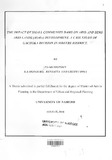| dc.description.abstract | Gachoka Division of Mbeere District is a semi arid area. Water is scarce in most part of
the division. In 1970, the area was supplied with a piped water but due to
mismanagement, the water supply is no longer functional. In 1979, the Government
through the Ministry of Agriculture established a Dam Construction Unit in the area with
the aim of soil and water conservation. In order to effectively conserve the soil and water
in the area they started construction of small community dams. Since then 43 small
community dams have been constructed by the Government, Non-governmental
Organizations and Religious Based Organizations. Due to rainfall unreliability in arid and
semi-arid areas there is need to conserve water during the rainy season for use during the
dry season through construction of both surface and subsurface darns. This study
undertook to investigate the impact of these dams on the recipient communities. It
analyzed the government policies on water and Arid and Semi Arid Lands (ASALs) rural
development since independence. This study also analyzed the sources of water before
dams were constructed, the sources of water during the rainy and dry season. It has also
looked at the method of water transport and the drawers of water. The study has also
analyzed the various uses of the water and how the dams are currently managed by the
users. The study has revealed that the dams are appropriate for storing water during the
rainy season for use during the dry season. The study has confirmed that the water from
the dams have been beneficial to the communities where the water is used for irrigation,
which has created employment by people selling the water which is used for irrigation.
TIllS act as a source of income during the dry season when there is no on farm
employment. The water is also used for rearing exotic dairy cattle, watering tree nurseries
and selling the water in the local market centres. This study also looked at the
management aspect of the dams, and it revealed that the dams require proper management
to avoid siltation and misuse, Those dams where the communities were not involved from
construction to implementation were found to have no management committees, were not
fenced and there was no control on the use of the water leading to direct watering of
animals in the dams which pollutes the water. Where communities were involved
throughout the dam planning, construction and implementation the dams had user
management committees, were fenced and there was control of the water use by the
communities through their elected management committees.
The study has recommended that the construction of the small community dams should be
combined with intensive soil conservation practices and catchment protection through
afforestation. Since this area is part of the catchment area of Tana river with Kamburu,
Gitaru, Kiambere and Kindaruma hydroelectric power generating dams downstream the
combination of water and soil conservation through the-construction of small dams would
be beneficial to the local community by increasing their access to more water and at the
same time reducing the 'siltation in Hydro Electric Power (H.E.P) dams hence enhancing
their capacity to produce electricity, which will be beneficial to the.nation as a whole | en |

